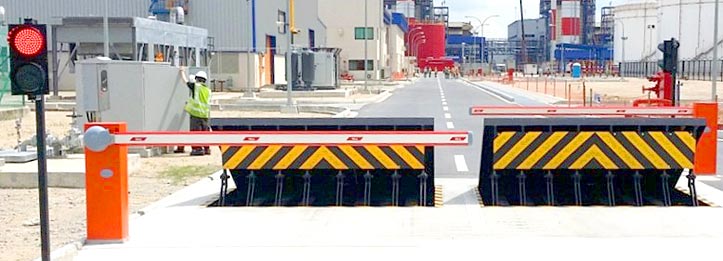The Buzz on Wedge Barriers
Wiki Article
Not known Factual Statements About Wedge Barriers
Table of ContentsThe smart Trick of Wedge Barriers That Nobody is Talking AboutThe Main Principles Of Wedge Barriers


The spring pole 58 is paired to a cam(e. g., cam 80 displayed in FIG. 4) of the lifting mechanism 50. The springs 60 disposed about the spring rod 58 are held in compression by springtime sustains 62, consisting of a repaired spring support 64. That is, the fixed spring support 64 is taken care of about the foundation 14 et cetera of the bather 10.
7 Easy Facts About Wedge Barriers Shown
The staying pressure applied to the cam camera deploy release wedge plate 16 may be provided supplied an electromechanical actuator 84 or other actuator. The springtime setting up 54 and the actuator 84(e. Wedge Barriers. g., electromechanical actuator)may run together to equate the cam and lift the wedge plate 16.
As mentioned over, the spring assembly 54 puts in a constant force on the webcam, while the electromechanical actuator might be regulated to put in a variable pressure on the cam, thus allowing the training try this out and lowering( i. e., releasing and withdrawing )of the wedge plate 16. In particular personifications, the continuous force used by the spring assembly 54 may be adjustable. g., electromechanical actuator) is handicapped. As will certainly be valued, the spring setting up 54 might be covered and protected from particles or various other components by a cover plate(e. g., cover plate 68 displayed in FIG. 4) that might be considerably flush with the raised surface area 38 of the foundation 14. As mentioned over, in the deployed position, the wedge plate 16 serves to obstruct accessibility or traveling beyond the barrier 10. The barrier 10(e. g., the wedge plate 16 )may block pedestrians or vehicles from accessing a home or pathway. As talked about above, the barrier 10 is connected to the support 30 safeguarded within the structure 14,

front brackets 71. As a result, the affiliation settings up 72 may pivot and rotate to allow the collapse and expansion of the linkage settings up 72 throughout retraction and release of the bather 10. The linkage settings up 72 reason movement of the wedge plate 16 to be restricted. If a vehicle is traveling towards the deployed wedge plate 16(e. For instance, in one situation, the safety legs 86 may be extended duringmaintenance of the barrier 10. When the security legs 86 are released, the safety and security legs 86 sustain the weight of the wedge plate 16 versus the surface 12. Consequently, the lifting system 50 may be shut off, serviced, eliminated, replaced, etc. FIG. 5 is partial viewpoint sight of a personification of the surface-mounted wedge-style obstacle 10, highlighting the webcam 80 and the webcam surfaces 82 of the lifting mechanism 50. Especially, two camera surfaces 82, which are referred to as reduced web cam surface areas 83, are placed below the web cam 80. The reduced camera surfaces 83 may be dealt with to the surface area 12 (e. As an Continued example, the lower cam surface areas 83 and the placing plate 85 may form a solitary piece that is secured to the support 30 by bolts or other mechanical bolts. Furthermore, two web cam surfaces 82, which are described as upper cam surface areas 87, are placed above the camera 80 and paired to (e. In other embodiments, interfering layers or plates might be positioned between the surface area 12 and the reduced webcam surface areas 83 and/or the wedge plate 16 and the top cam surfaces 87 As mentioned over, the webcam 80 converts along the webcam surface areas 82 when the wedge plate 16 is lifted from the retracted placement to the deployed placement. Additionally, as pointed out above, the springtime setting up 54 (see FIG. 3 )may give a force acting upon the webcam 80 in the instructions 102 by means of springtime rod 58, which might lower the force the electromechanical actuator 84 is called for to apply to the cam 80 in order to actuate and raise the wedge plate 16. 1 )to the released setting(see FIG. 4). As revealed, the webcam 80 consists of track wheels 104(e. g., rollers), which contact and equate along the web cam surfaces 82 throughout procedure.
Report this wiki page